
How many countries are nuclear powers? There are 9 countries that have nuclear weapons. They are the United States, Russia, China, France, the United Kingdom, Pakistan, India, Israel, and North Korea. Between them, they have a grand total of 13,000 nuclear weapons. One nuclear weapon can destroy a city. If all 13,000 of those nuclear weapons were launched at the same time, they would destroy all human life and almost all other life as well. For probably centuries. These are rough figures, but these are how many nuclear weapons each country has. Russia has 5,889. The United States has 5,224. China has 410. France has 290. The United Kingdom has 225. Pakistan has 170. India has 164. Israel has 90. And North Korea has 30. These are rough numbers because the numbers change and some nations don’t report exactly how many they have.
The theory behind nuclear weapons became possible with the discovery of the atom in the 19th century. In the early 20th century, the atomic nucleus was discovered and that some atoms gave off energy. Scientists wondered if the atoms around us could be tapped for their energy. They meant for the good of society, but it didn’t end up that way. It wasn’t long before people started to speculate about the military applications if someone could work out how to release all of this energy. When the Nazis came to power, a Jewish scientist called Leo Szilard escaped to London, where he discovered the nuclear chain reaction. He believed it was only a matter of time before the Nazis came up with the same idea, so he urged Britain and America to work on it first. The Manhattan Project was launched in 1942 and the first nuclear bomb was tested on July 16th, 1945. Then, of course, on August 6th and August 9th, the first and last atomic bombs dropped on a populated area where dropped over Japan.
Roughly half a year after the US dropped its bombs on Hiroshima and Nagasaki, the UN made a resolution to “deal with the problems raised by the discovery of atomic energy”. Ideally, they wanted to ban them, but after World War 2, the US had too much power and was too wary of other countries managing to make a bomb to allow that, so it ended up just making proposals. And, sure enough, within 3 years, the Soviet Union tested its first nuclear bomb. Interestingly, the US announced the Soviet nuclear bomb test to the world before the Soviets did because they registered the atmospheric radiation.
Once the USSR had nuclear bombs, the arms race was on and both countries threw money into making as many bombs as they could. By 1950, the United States had 299 bombs and the Soviet Union had 5. They had only just tested their first one and it would take them a while to get going. In the meantime, the United Kingdom managed to make a nuclear bomb and they tested two of them in Australia in 1952. Britain had been heavily involved in the early days of nuclear weapons, even before America. However, once the Manhattan Project got underway, the enormous resources of America began to show and they developed the bomb faster than any other country. This could be considered a good thing, because Britain had to consider the possibility that Germany could build a bomb if the UK went it alone. It took them a little longer, but they managed to build one and in 1955, the US has 2,422, the USSR has 200, and the UK has 14.
France is the next country to jump on the nuclear bandwagon. They tested their first bomb in 1960 and in 1964, China tested their first. By 1965, the US has 31,149 bombs, the USSR has 6,129, the U has 42, France had 32, and China had 5. In 1974, India tested their first nuclear bomb and sometime in the 1970s, Israel became a nuclear power as well. Israel never admitted, and still doesn’t admit, that they have nuclear weapons, but experts believe that they have over 100 and that they built their first nuclear bomb in the early 1970s. Pakistan and India have always been enemies and Pakistan didn’t feel safe with a nuclear armed India on their border, so Pakistan became a nuclear country. North Korea is the last country to develop nuclear power and they tested their first bomb in 2006. How many nuclear weapons they have is unknown.
The number of nuclear weapons in the world peaked in 1985, when there were 61,662. Since then, the number has fallen drastically, but their power, range, and efficiency has increased. Nuclear countries spend hundreds of millions of dollars every year keeping their systems running. The idea is, of course, MAD (Mutually Assured Destruction). The number of missiles is dropping, but it is doubtful that it will ever reach zero, at least in the current world. And this is what I learned today.
Image By Federal government of the United States – https://www.atomicheritage.org/history/hydrogen-bomb-1950, Public Domain, https://commons.wikimedia.org/w/index.php?curid=12656652
Sources
https://en.wikipedia.org/wiki/History_of_nuclear_weapons
https://www.icanw.org/nuclear_weapons_history
https://www.icanw.org/catastrophic_harm
https://www.space.com/how-did-we-discover-atoms.html
https://en.wikipedia.org/wiki/Historical_nuclear_weapons_stockpiles_and_nuclear_tests_by_country
https://assets.publishing.service.gov.uk/media/5a7987e840f0b642860d8d88/Cm6994_Factsheet5.pdf
